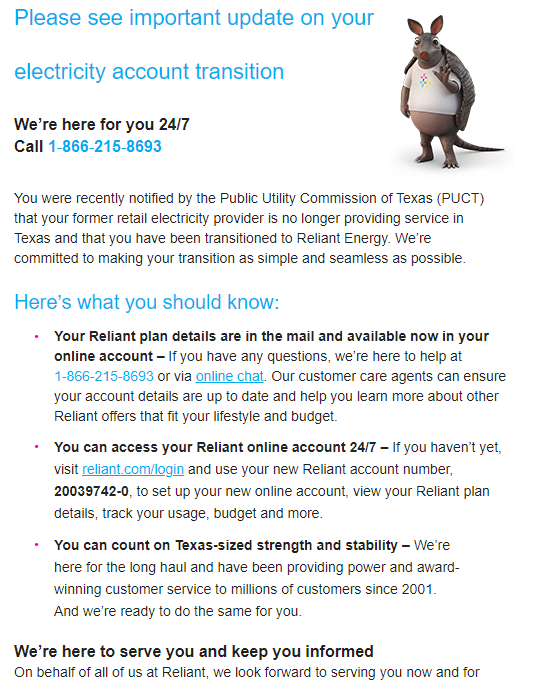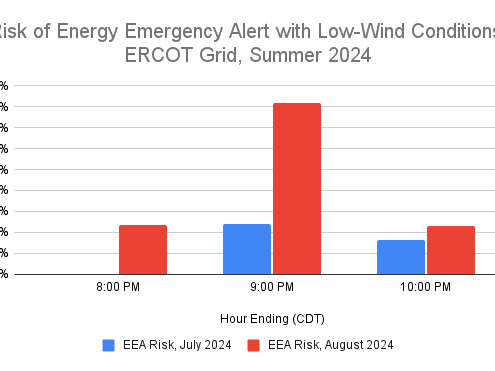Last Updated on July 24, 2022 by Mary Pressler

Since V247 has gone out of business, Energy Ogre customers are immediately switched to POLR, with a higher rate.
What is a POLR or Provider of Last Resort?
In most regions of Texas, you can choose your retail electricity provider (REP). However, what happens if your provider goes out of business? Texas has a deregulated electric sector, where the companies in charge of the power grid (e.g. Oncor, CenterPoint) are dedicated exclusively to that job, and not allowed to sell electricity. To make sure that no consumers are left without energy when an REP goes out of business, the Public Utility Commission of Texas designates a Provider of Last Resort (POLR) in each service territory.
There are a few important things you must know about Providers of Last Resort:
- They are large electricity providers who are financially stable, which means they can absorb the entire customer base of REPs who go out of business.
- The Public Utility Commission of Texas designates a POLR for each service territory every two years.
- A POLR operates like any other electricity provider, which means they offer multiple electricity plans. However, the POLR plan is the one you get by default when your current provider goes out of business.
- POLR electricity plans have high kilowatt-hour prices Being a POLR involves a financial risk, since the designated company has no way to predict how many customers will require the service. For this reason, they charge a higher profit margin.
- The POLR plan does not have a binding contract, which means you can switch to another electricity plan as soon as you find it.
A POLR electricity plan is not intended as a permanent solution when your provider goes out of business. It can be best described as a safety measure that gives you time to find another provider. You can even switch to a more favorable plan offered by the POLR itself. Keep in mind they are normal electricity retailers with competitive plans, who are given the responsibility of absorbing customers left without a provider.
In fact, you can choose to be placed on the POLR electricity plan of your service territory. However, this makes no sense financially because you are voluntarily paying a high tariff.
What Happens If I Stay on the POLR Electricity Plan?
POLR rates are much higher than what you can find in the open market. If you are left with this premium rate, you should switch as quickly as possible to avoid a high bill. Note that the POLR will often charge a deposit if you don’t choose another plan within 15 days.
Generally, the designated POLR will switch you to one of their variable-rate electricity plans if you’re still on the POLR plan after 60 days. However, waiting for this point is not recommended at all: by then, you will have paid above-average electricity prices for two months.
The PUCT will notify you when an REP is going out of business and you’re being placed on the POLR tariff, but only if they have updated contact information. You should also receive notifications from your current provider and the POLR.

Being switched to another electricity provider can be frustrating, but you still have a choice.
Who Is the Provider of Last Resort for Each TDU?
The ERCOT power grid is divided into five service territories, each assigned to a different Transmission and Distribution Utility (TDU):
- Oncor
- AEP Texas Central
- CenterPoint
- AEP Texas North
- TNMP
As mentioned above, these TDUs are dedicated exclusively to the grid: operation, maintenance, capacity upgrades, etc. They make sure electricity is delivered to homes and businesses, but are not allowed to sell it directly. The Provider of Last Resort depends on the service territory where a building is located, but also on the type of electricity consumer: residential, small non-residential, medium non-residential, and large non-residential.
The following table summarizes the POLRs for the residential market in each service territory, and the kilowatt-hour price you can expect to pay at different consumption levels. You can check the Electricity Facts Label of each plan at the PUCT website.
| Service Territory | Residential POLR | Average Price at 500 kWh | Average Price at 1,000 kWh | Average Price at 1,500 kWh |
| Oncor | TXU | 16.6 cents/kWh | 16.3 cents/kWh | 16.1 cents/kWh |
| CenterPoint | Reliant | 14.9 cents/kWh | 14.5 cents/kWh | 14.3 cents/kWh |
| AEP Texas Central | TXU | 17.7 cents/kWh | 17.1 cents/kWh | 16.8 cents/kWh |
| AEP Texas North | TXU | 17.3 cents/kWh | 16.7 cents/kWh | 16.4 cents/kWh |
| TNMP | TXU | 18.3 cents/kWh | 17.5 cents/kWh | 17.1 cents/kWh |
For comparison, the average price for residential consumers in Texas is 12.28 cents/kWh, according to the US Energy Information Administration (latest data available as of May 2022). As you can see in the table above, POLR electricity prices are 16%-45% above the state average.
The PUCT also assigns a Provider of Last Resort for non-residential consumers, which varies depending on the energy consumption level. You check the Electricity Facts Label for these plans, but average prices per kWh are not provided for medium and large consumers. The calculation procedure of non-residential power bills is more complex, since it involves both energy and demand charges.
| Service Territory | POLR, Small Non-Residential | POLR, Medium Non-Residential | POLR, Large Non-Residential |
| Oncor | TXU | TXU | TXU |
| CenterPoint | Reliant | Reliant | Calpine |
| AEP Texas Central | Reliant | TXU | Reliant |
| AEP Texas North | Reliant | TXU | Reliant |
| TNMP | Reliant | TXU | Reliant |
You can also download the Electricity Facts Labels for the 15 plans in the table above. However, average kWh prices are only provided for the small non-residential sector. The EFLs for medium and large consumers only provide a calculation procedure, since kWh prices become highly variable due to the presence of demand charges.
| Service Territory | POLR, Small Non-Residential | Average Price at 1,500 kWh | Average Price at 2,500 kWh | Average Price at 3,500 kWh |
| Oncor | TXU | 16.2 cents/kWh | 15.3 cents/kWh | 15.0 cents/kWh |
| CenterPoint | Reliant | 13.6 cents/kWh | 11.8 cents/kWh | 11.9 cents/kWh |
| AEP Texas Central | Reliant | 17.2 cents/kWh | 15.3 cents/kWh | 15.3 cents/kWh |
| AEP Texas North | Reliant | 16.2 cents/kWh | 14.8 cents/kWh | 14.8 cents/kWh |
| TNMP | Reliant | 19.7 cents/kWh | 15.3 cents/kWh | 15.3 cents/kWh |
These tariffs assume no demand charge for consumers using 1,500 kWh, a demand of 11 kW for the 2,500 kWh range, and 16 kW for the 3,500 kWh range. Note that the average price per kWh will vary depending on the demand factor.
What Causes an Electricity Provider to Go Out of Business?
In all business sectors, some companies thrive while others go bankrupt. In the case of deregulated electricity markets, REPs go out of business when they can no longer meet their obligations. For example, this can happen if they are forced to purchase large amounts of energy in the wholesale market when peak prices are being charged.
- REPs know that the highest prices are generally charged on the hottest days of summer, when electricity demand reaches its annual peak due to air conditioning.
- To avoid expensive energy purchases at spot prices, kilowatt-hours are purchased in bulk and in advance. Events where many REPs go out of business at once are very rare, but they happen.
A recent example is Winter Storm Uri in February 2021: The grid experienced peak demand at an unusual time of the year, and many REPs could not meet their obligations.
When Breeze Energy went out of business in May 2018, around 10,000 consumers were placed on the POLR tariff. Around half of these customers were from the CenterPoint service territory. Breeze Energy had been operating for 20 years in Texas, but they were forced to close when ERCOT found that the company was no longer able to meet its financial obligations.
Note: More recently, Energy Ogre members are scrambling to find a new energy provider after being switched to Reliant at a premium rate. Energy Ogre is an electricity club that charges it’s clients $10 per month to find the lowest electric rate. If you’re a current Energy Ogre customer and choose to switch providers on your own, you will still need to call and cancel your account to avoid the $10 monthly fee.









